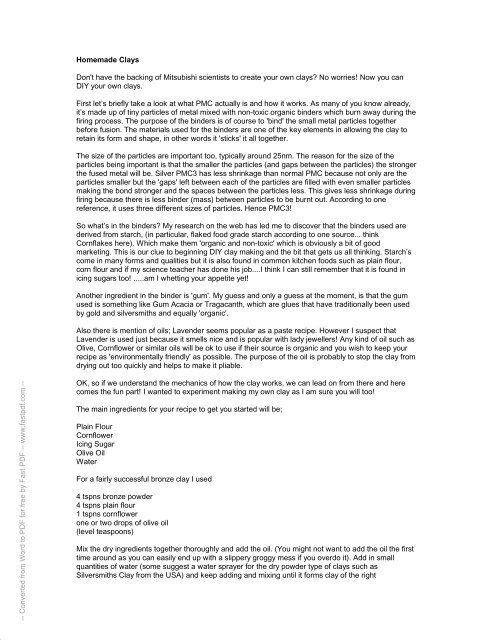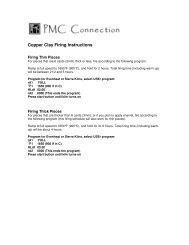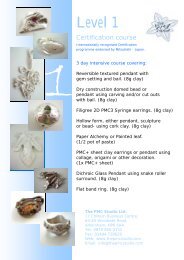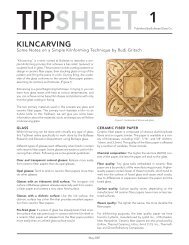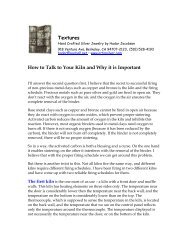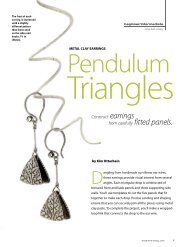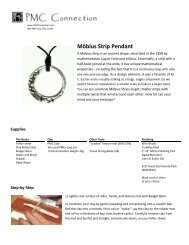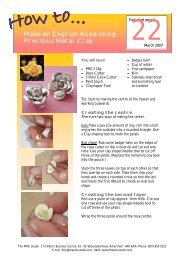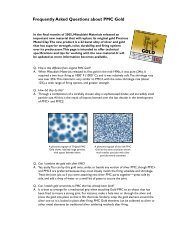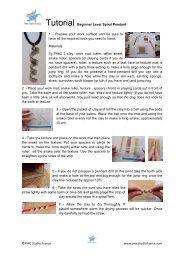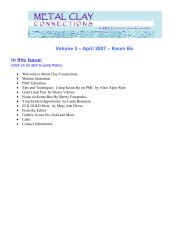Homemade Clays - Metal Clay Academy
Homemade Clays - Metal Clay Academy
Homemade Clays - Metal Clay Academy
You also want an ePaper? Increase the reach of your titles
YUMPU automatically turns print PDFs into web optimized ePapers that Google loves.
<strong>Homemade</strong> <strong><strong>Clay</strong>s</strong><br />
Don't have the backing of Mitsubishi scientists to create your own clays? No worries! Now you can<br />
DIY your own clays.<br />
First let’s briefly take a look at what PMC actually is and how it works. As many of you know already,<br />
it’s made up of tiny particles of metal mixed with non-toxic organic binders which burn away during the<br />
firing process. The purpose of the binders is of course to 'bind' the small metal particles together<br />
before fusion. The materials used for the binders are one of the key elements in allowing the clay to<br />
retain its form and shape, in other words it 'sticks' it all together.<br />
The size of the particles are important too, typically around 25nm. The reason for the size of the<br />
particles being important is that the smaller the particles (and gaps between the particles) the stronger<br />
the fused metal will be. Silver PMC3 has less shrinkage than normal PMC because not only are the<br />
particles smaller but the 'gaps' left between each of the particles are filled with even smaller particles<br />
making the bond stronger and the spaces between the particles less. This gives less shrinkage during<br />
firing because there is less binder (mass) between particles to be burnt out. According to one<br />
reference, it uses three different sizes of particles. Hence PMC3!<br />
So what’s in the binders? My research on the web has led me to discover that the binders used are<br />
derived from starch, (in particular, flaked food grade starch according to one source... think<br />
Cornflakes here). Which make them 'organic and non-toxic' which is obviously a bit of good<br />
marketing. This is our clue to beginning DIY clay making and the bit that gets us all thinking. Starch’s<br />
come in many forms and qualities but it is also found in common kitchen foods such as plain flour,<br />
corn flour and if my science teacher has done his job....I think I can still remember that it is found in<br />
icing sugars too! .....am I whetting your appetite yet!<br />
Another ingredient in the binder is 'gum'. My guess and only a guess at the moment, is that the gum<br />
used is something like Gum Acacia or Tragacanth, which are glues that have traditionally been used<br />
by gold and silversmiths and equally 'organic'.<br />
Also there is mention of oils; Lavender seems popular as a paste recipe. However I suspect that<br />
Lavender is used just because it smells nice and is popular with lady jewellers! Any kind of oil such as<br />
Olive, Cornflower or similar oils will be ok to use if their source is organic and you wish to keep your<br />
recipe as 'environmentally friendly' as possible. The purpose of the oil is probably to stop the clay from<br />
drying out too quickly and helps to make it pliable.<br />
-- Converted from Word to PDF for free by Fast PDF -- www.fastpdf.com --<br />
OK, so if we understand the mechanics of how the clay works, we can lead on from there and here<br />
comes the fun part! I wanted to experiment making my own clay as I am sure you will too!<br />
The main ingredients for your recipe to get you started will be;<br />
Plain Flour<br />
Cornflower<br />
Icing Sugar<br />
Olive Oil<br />
Water<br />
For a fairly successful bronze clay I used<br />
4 tspns bronze powder<br />
4 tspns plain flour<br />
1 tspns cornflower<br />
one or two drops of olive oil<br />
(level teaspoons)<br />
Mix the dry ingredients together thoroughly and add the oil. (You might not want to add the oil the first<br />
time around as you can easily end up with a slippery groggy mess if you overdo it). Add in small<br />
quantities of water (some suggest a water sprayer for the dry powder type of clays such as<br />
Silversmiths <strong>Clay</strong> from the USA) and keep adding and mixing until it forms clay of the right
consistency for you! What we have basically<br />
made is a DIY form of 'Play-doh' with metal<br />
powder added. You may also wish to add warm<br />
water as it will affect the way that the<br />
Cornflower behaves in the mixture. Using Self-<br />
Raising flour might be interesting in forming<br />
'Aero' like forms and you might want to<br />
experiment with this by adding Baking Soda to<br />
your plain flour.<br />
On the right is a picture of the clay and also<br />
some pieces I torch fired.<br />
The Bronze clay recipe can sometimes be torch<br />
fired depending on the thickness of the piece<br />
you are firing. How this works without using<br />
coconut shell is a bit of a mystery...which I only stumbled upon because of my eagerness to try out if<br />
my research had paid off! I think that probably the small amount of icing sugar is causing enough<br />
carbon to help the sintering process.<br />
The method for firing I’ve been using is 'experience' which is hard to quantify but in main, bring the<br />
piece gently up to temperature as with normal PMC...hold the temp when the binders start to burn<br />
away. ie by removing the torch flame, then adding it again until all the binder has burnt away....then<br />
zap it with the hottest flame you can get until the surface starts to slightly shimmer and eddy. As it<br />
starts to shimmer, keep moving the torch to control the temp at shimmering level....I repeat this<br />
process about three times, letting the piece slightly cool to a dull orange....then repeat the process<br />
again bringing it up to shimmer. Turning the piece over will also help make a good fusion if the piece<br />
has been laying on a flat soldering block or charcoal.....ah..Think I may have just discovered why it<br />
torch fires....it’s probably not the icing sugar but the charcoal soldering block I fired it on that’s causing<br />
enough de-oxidation!<br />
Of course the reason why we need to use something like coconut shell is to stop the particles from<br />
oxidising too much which stops them from fusing together properly. Although I’ve yet to try it, adding a<br />
touch of Borax BP from the chemist might help 'flux' the particles and reduce oxidization.<br />
-- Converted from Word to PDF for free by Fast PDF -- www.fastpdf.com --<br />
I am sure you will devise your own recipes and I hope that you do but I also hope I have given you<br />
enough info and pointers to be able to experiment and realise that PMC is not beyond the scope of<br />
the kitchen table!<br />
Happy creating and experimenting!<br />
Del Feast<br />
Biography of Del Feast<br />
<strong>Metal</strong>work, designing and photography have been important themes that have run throughout Del's<br />
career. His background is in electrical and mechanical engineering where in his spare time he would<br />
use the factory’s equipment to make jewellery. In 1976 he worked briefly for a manufacturing jewellers<br />
based in Fulham. He then followed a career in sales and marketing and it wasn't until he took a<br />
degree in the Fine Arts some years later, after running his own graphics business, that the interest in<br />
jewellery was re-kindled and his knowledge of engineering could be matched with his creative skills.<br />
Del now enjoys jewellery making as a leisurely hobby interest and with the advent of metal clays, is<br />
now pursuing new creative avenues and exploring its unique properties, which he says is helping him<br />
keep his interest in designing and making alive.


